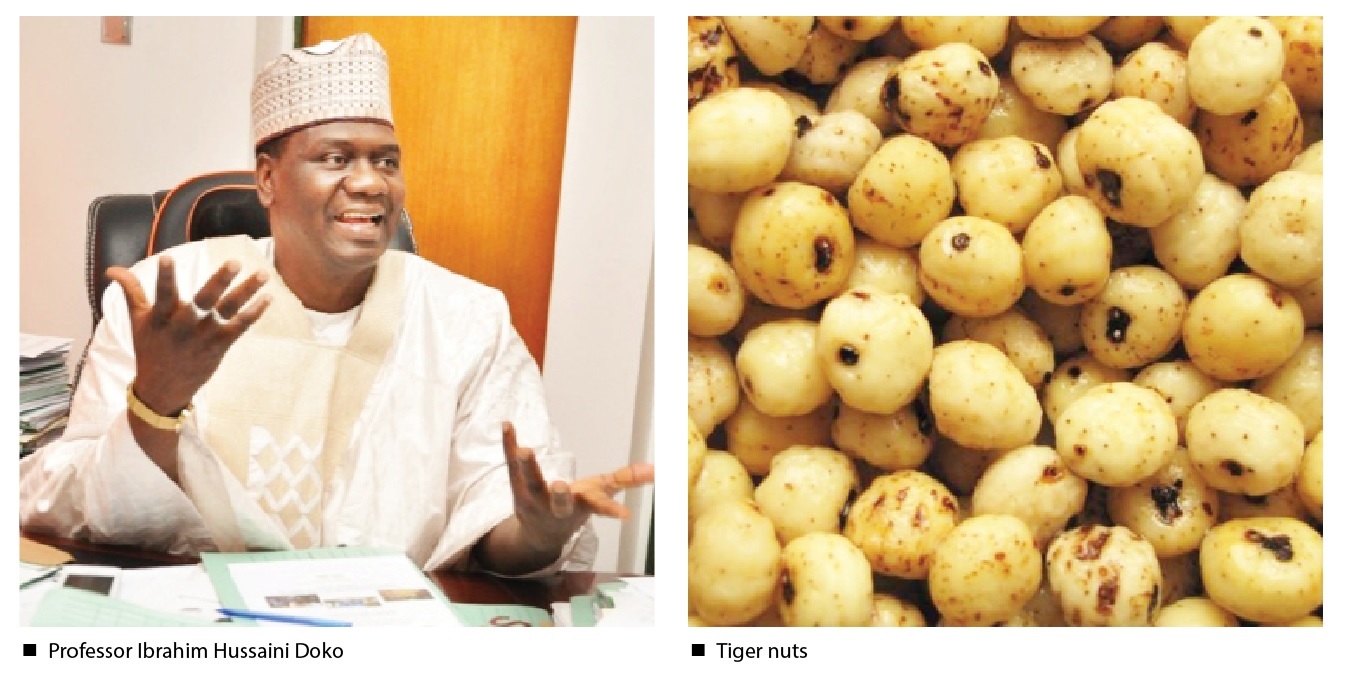Why farmers should focus more on tiger nut cultivation – RMRDC
Professor Ibrahim Hussaini Doko is the Director-General of the Raw Material Research and Development Council (RMRDC). In this interview, he spoke on the federal government’s efforts to encourage tiger nuts farming, saying if the crop’s value chain is adequately harnessed, it can fetch the country over N20 billion annually. Excerpt: What are tiger nuts and […]

Professor Ibrahim Hussaini Doko
Professor Ibrahim Hussaini Doko is the Director-General of the Raw Material Research and Development Council (RMRDC). In this interview, he spoke on the federal government’s efforts to encourage tiger nuts farming, saying if the crop’s value chain is adequately harnessed, it can fetch the country over N20 billion annually. Excerpt:
What are tiger nuts and where are they found?
There are three varieties of tiger nut tubers easily identified based on their colour. They are the yellow, brown and black varieties. However, only two of the varieties – yellow and brown – are commonly seen in most local markets in Nigeria. The yellow variety is further grouped into big and small yellow varieties.
The origin of tiger nut cultivation was traced to ancient Egypt. Thousands of years ago, the cultivation of the crop was reported to take place between Sudan and Egypt on the shores of the Nile River. It is also cultivated in Southern Europe and parts of West Africa, most especially Ghana, Nigeria, Sierra Leone, Cameroon, Senegal, Guinea and Cote d’Ivore.
In Nigeria, tiger nut is grown mainly in the northern region, especially, Katsina State and the tuber is available in the market all year round.
What are the agronomic practices of tiger nut in Nigeria?
Tiger nut is not a new plant species in Nigeria. The cultivation of tiger nut requires mild climate and sandy soil. It is planted in April and harvested in November. The planting period is grouped into major (April-July) and minor (September-November) seasons.
Tiger nut requires irrigation until the tubers are due for harvesting. It has been established through R&D that the mineral contents and acceptability of tiger nut-milk is affected by the location and planting period.
How is tiger nut preserved in Nigeria?
The tubers of tiger nut could be utilized when they are fresh, semi-fresh or dried depending on the products desired. Drying of tiger nut tubers is usually done by exposing them to direct sun rays with occasional turning which ensures uniform drying. A properly sun-dried tiger nut tuber takes about 1-2 months to complete.
Dried tiger nut tuber is resistant to microbial spoilage. The weight of fresh tiger nut tuber is 70-900mg but when it is dried it is reduced to 30-350mg. The length of the fresh tiger nut tuber is about 30mm. When soaked in water, the dried tuber can absorb close to three times the weight of water compared with the weight of the dried tuber. Apart from preventing microbial spoilage, drying of the tubers ensures that the nutritional quality of tiger nut tubers is preserved
What are the properties of tiger nut and why is it so important?
As a result of its importance in the nutrition of many people in various countries, studies have been carried out on the nutritional composition of different varieties of tiger nut tubers grown in different geographical locations.
As utilisation of tiger nut tubers for development of diverse edible products is being prioritized globally, more attention is being paid to the nutritional composition of tiger nut-derived products. Studies have shown that protein and ash content of tiger nut flour separately obtained from two varieties of tiger nut tubers increased after the crop’s tubers were subjected to germination.
In terms of proximate composition, flour obtained from the brown variety showed higher protein, fat, ash, potassium, magnesium, manganese and iron content than the yellow variety. On the other hand, the yellow variety contains higher amount of carbohydrate, crude fibre, calcium, sodium and copper.
The quantity of the milk produced by the yellow, as well as its fat and protein contents are higher than those from the black variety. The antinutritional factors, especially, polyphenols present in the yellow variety are lower than what is obtainable in the black variety. However, the black variety contains more quantity of oil.
Also, studies on the proximate composition, metabolizable energy, amino acid profiles and isoelectric properties of the nut indicated that site and planting period have significant effects on the fat, protein, minerals and energy content of the milk produced from the two varieties.
Also affected are the sensory characteristics of tiger nut milk produced from the two varieties planted in different sites and planting periods.
If the nuts have the potentials so enumerated, the industrial potentials can be very high. Can you elucidate some of the industrial potentials of the nut?
In view of its nutritional characteristics, tiger nut is being used to produce a number of products globally. Three main products obtained from Cyperus esculentus are tiger nut milk, tiger nut flour and tiger nut oil.
The development of other products involves any of the three main products or their combination. A ready-to-eat crunchy snack called gurundi is being produced using the flour. A highly nutritious beverage known as Bambara nut-tiger, not coconut, milk can also been prepared using tiger nut-milk derived from the tubers.
Tiger nut is used to produce ‘kunun aya’ which is a non-alcoholic, low viscous, sweet-sour beverage that has milky and creamy appearance and taste.
Tiger nut milk is a common drink prepared locally in northern Nigeria. It has also
